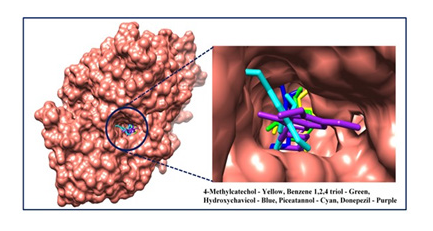Anti-Alzheimer’s Potential of Different Varieties of Piper betle Leaves and Molecular Docking Analyses of Metabolites
DOI:
https://doi.org/10.5530/fra.2021.1.3Keywords:
Piper betle, Acetylcholinesterase, GC-MS, Molecular docking, HPTLC, PhenolAbstract
Introduction: Acetylcholinesterase inhibitors are used to prevent symptoms of Alzheimer’s disease which is initiated due to oxidative stress. Piper betle L. is a tropical evergreen perennial vine whose leaves are widely consumed as masticator in Asia and has medicinal properties. Objectives: The present study is aimed to investigate acetylcholinesterase inhibitory property of methanolic extracts of different varieties of Piper betle leaves and chemometrically identify different bioactive ingredients in vitro and in silico. Materials and Methods: Methanol extracts of the leaves collected in February and October from eight varieties of P. betle (Chhanchi, Bagerhati, Manikdanga, Kalibangla, Bangla, Ghanagete, Meetha and Haldi) were studied for acetylcholinesterase inhibitory properties. Chemical components were analyzed by Gas Chromatography – Mass spectrometry and High Performance Thin Layer Chromatography. Active metabolites were identified chemometrically. The activities were proved in vitro and in silico. Results: All the extracts inhibited acetylcholinesterase. Statistical analysis suggested that several phenolic compounds were correlated to anti-cholinesterase activity. Piceatannol, hydroxychavicol, benzene-1,2,4-triol, and 4-methylcatechol are reported here to have such enzyme inhibitory properties. These four small molecules were further subjected to molecular docking analysis to explore their binding mechanism with the acetylcholinesterase enzyme. All the four small molecules are found to interact with the targeted enzyme in similar fashion like the molecular interactions observed for the standard inhibitor, Donepezil, at the active site of acetylcholiesterase. Conclusion: Thus, consumption of P. betle leaves may have a beneficial effect in the prevention and treatment of this neurodegenerative disease.
Downloads
Metrics





